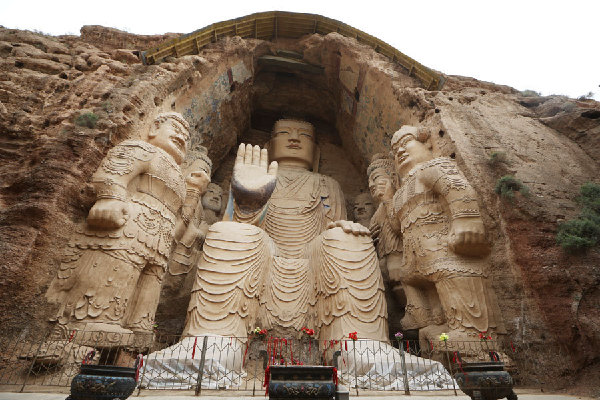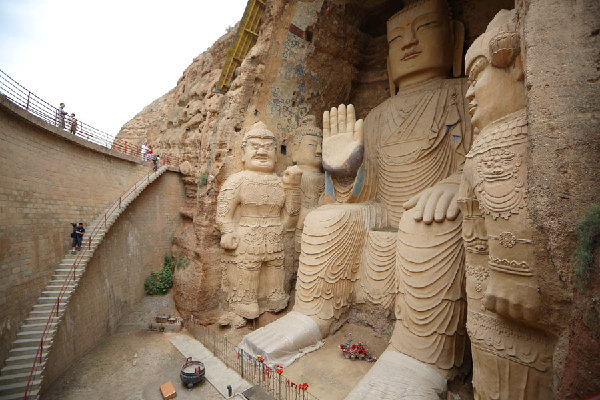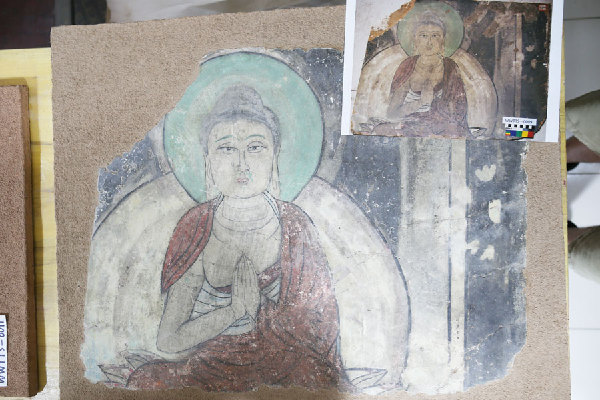Sights
Tiantishan Grottoes (Wuwei)
Updated: 2013-11-02( Chinadaily.com.cn )
The Tiantishan Grottoes in central Gansu province's Wuwei county were dug about 1,600 years ago. Tianti means "ladder to the sky" and shan means mountain. The site is a honeycomb of 17 caves in three layers. The biggest cavern is 30 meters high, 19 meters wide and 16 meters deep. It houses a Sakyamuni statue that is 15 meters high and 10 meters wide, and smaller peripheral caves and murals. Experts have collected some of the site's relics for restoration. The local government built a 10-meter-high dam to protect the caves from water damage.
 |
|
The Tiantishan Grottoes in central Gansu province's Wuwei county were dug about 1,600 years ago. Tianti means "ladder to the sky" and shan means mountain. The site is a honeycomb of 17 caves in three layers. The biggest cavern is 30 meters high, 19 meters wide and 16 meters deep. It houses a Sakyamuni statue that is 15 meters high and 10 meters wide, and smaller peripheral caves and murals. Experts have collected some of the site's relics for restoration. The local government built a 10-meter-high dam to protect the caves from water damage. Visitors can view the big Buddha statue from the top of the dam and take ladders down to the statue's feet.[Photo by Chen Xi/China Daily] |
 |
|
The Tiantishan Grottoes in central Gansu province's Wuwei county were dug about 1,600 years ago. Tianti means "ladder to the sky" and shan means mountain. The site is a honeycomb of 17 caves in three layers. The biggest cavern is 30 meters high, 19 meters wide and 16 meters deep. It houses a Sakyamuni statue that is 15 meters high and 10 meters wide, and smaller peripheral caves and murals. Experts have collected some of the site's relics for restoration. The local government built a 10-meter-high dam to protect the caves from water damage. Visitors can view the big Buddha statue from the top of the dam and take ladders down to the statue's feet.[Photo by Chen Xi/China Daily] |
 |
|
The Tiantishan Grottoes in central Gansu province's Wuwei county were dug about 1,600 years ago. Tianti means "ladder to the sky" and shan means mountain. The site is a honeycomb of 17 caves in three layers. The biggest cavern is 30 meters high, 19 meters wide and 16 meters deep. It houses a Sakyamuni statue that is 15 meters high and 10 meters wide, and smaller peripheral caves and murals. Experts have collected some of the site's relics for restoration. The local government built a 10-meter-high dam to protect the caves from water damage. Visitors can view the big Buddha statue from the top of the dam and take ladders down to the statue's feet.[Photo by Chen Xi/China Daily] |
 |
|
The Tiantishan Grottoes in central Gansu province's Wuwei county were dug about 1,600 years ago. Tianti means "ladder to the sky" and shan means mountain. The site is a honeycomb of 17 caves in three layers. The biggest cavern is 30 meters high, 19 meters wide and 16 meters deep. It houses a Sakyamuni statue that is 15 meters high and 10 meters wide, and smaller peripheral caves and murals. Experts have collected some of the site's relics for restoration. The local government built a 10-meter-high dam to protect the caves from water damage. Visitors can view the big Buddha statue from the top of the dam and take ladders down to the statue's feet.[Photo by Chen Xi/China Daily] |
 |
|
The Tiantishan Grottoes in central Gansu province's Wuwei county were dug about 1,600 years ago. Tianti means "ladder to the sky" and shan means mountain. The site is a honeycomb of 17 caves in three layers. The biggest cavern is 30 meters high, 19 meters wide and 16 meters deep. It houses a Sakyamuni statue that is 15 meters high and 10 meters wide, and smaller peripheral caves and murals. Experts have collected some of the site's relics for restoration. The local government built a 10-meter-high dam to protect the caves from water damage. Visitors can view the big Buddha statue from the top of the dam and take ladders down to the statue's feet.[Photo by Chen Xi/China Daily] |


